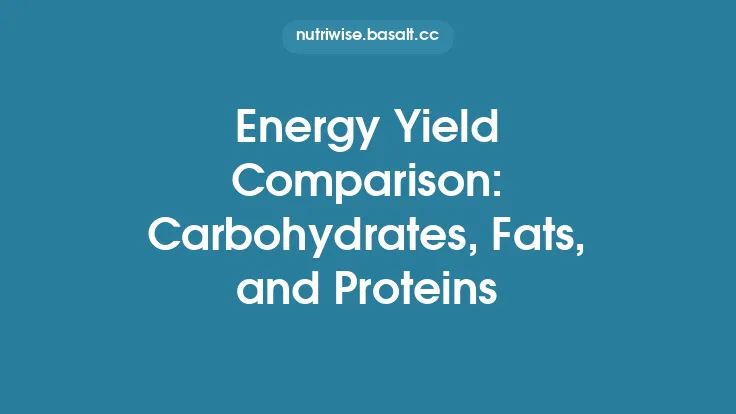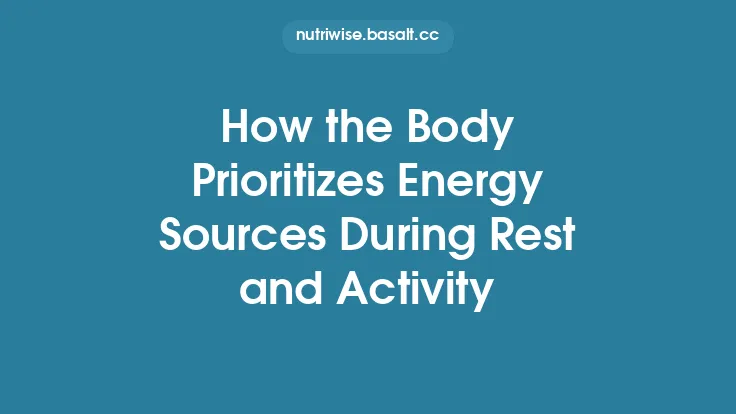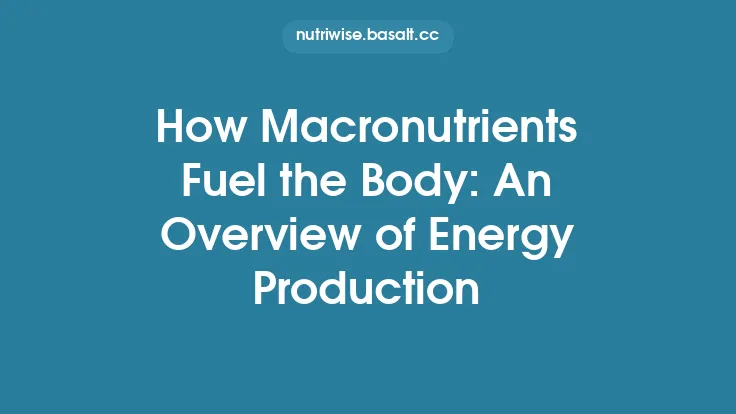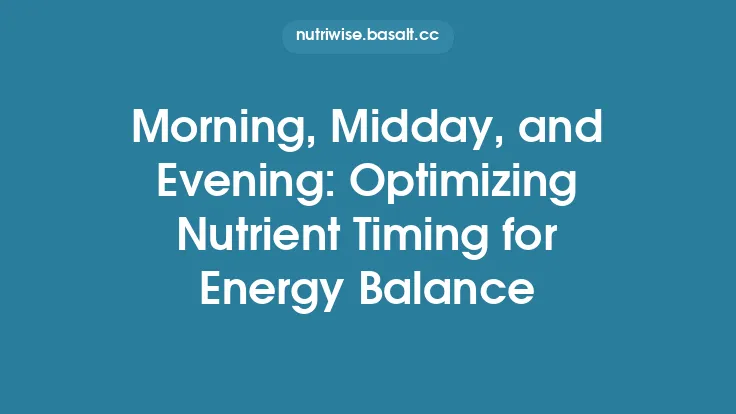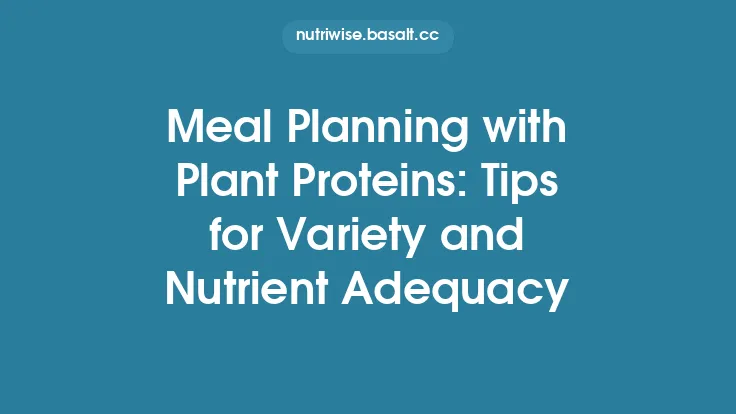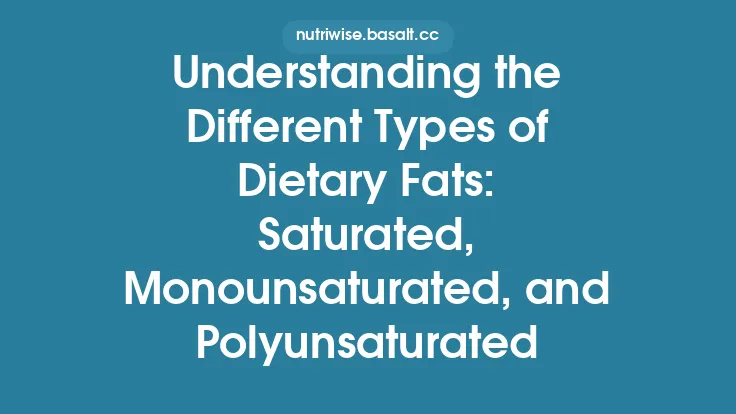The body’s handling of the three macronutrients—carbohydrates, fats, and proteins—is a finely tuned choreography that determines whether a nutrient is burned for immediate energy, stored for later use, or diverted into building blocks for growth and repair. This “nutrient partitioning” process begins the moment food leaves the mouth and continues through the bloodstream, into cells, and finally into the mitochondria where ATP is produced. Understanding how the body prioritizes each macronutrient provides insight into everyday phenomena such as why a sugary snack can give a quick burst of energy, why a high‑fat meal leaves you feeling satiated for longer, and why protein intake after resistance training supports muscle repair. Below, we explore the major steps and decision points that dictate the fate of digested nutrients, emphasizing the physiological logic rather than the detailed enzymatic pathways that belong to other specialized articles.
Digestive Processing and Initial Fate of Nutrients
Carbohydrates are broken down by salivary and pancreatic amylases into mono‑ and disaccharides (primarily glucose, fructose, and galactose). These sugars are absorbed across the intestinal epithelium via specific transporters (SGLT1 for glucose/galactose, GLUT5 for fructose) and enter the portal circulation, delivering a rapid supply of glucose directly to the liver.
Fats undergo emulsification by bile salts, followed by enzymatic hydrolysis by pancreatic lipase, producing free fatty acids (FFAs) and monoacylglycerol. Inside enterocytes, these lipids are re‑esterified into triglycerides and packaged into chylomicrons—large lipoprotein particles that travel through the lymphatic system before entering the systemic circulation.
Proteins are hydrolyzed by gastric pepsin and pancreatic proteases into oligo‑ and di‑peptides, which are further broken down by brush‑border peptidases into free amino acids. These amino acids are absorbed via sodium‑dependent transporters and appear in the portal vein, where the liver again serves as the first checkpoint.
The liver’s central position allows it to act as a “gatekeeper,” deciding whether nutrients are released into the systemic circulation, stored, or transformed into other compounds. This early triage sets the stage for the body’s hierarchical use of macronutrients.
Carbohydrate Partitioning: Immediate Oxidation vs. Storage
- Rapid Availability – Because glucose can be oxidized directly in most tissues, the body gives it top priority when energy demand spikes (e.g., during high‑intensity exercise or acute stress). Insulin released in response to rising blood glucose promotes uptake into muscle and adipose tissue via GLUT4 translocation.
- Liver’s Dual Role – The liver can store excess glucose as glycogen (glycogenesis) or convert it to fatty acids (de novo lipogenesis) when glycogen stores are saturated. However, de novo lipogenesis from carbohydrate is relatively inefficient and typically only becomes significant under chronic over‑feeding.
- Sparing of Other Fuels – While glucose is abundant, the oxidation of fatty acids and amino acids is down‑regulated. This “glucose‑first” strategy conserves fat reserves and nitrogen, ensuring that the body can rely on more abundant carbohydrate supplies for immediate ATP production.
- Post‑prandial Clearance – Within 2–4 hours after a carbohydrate‑rich meal, blood glucose levels return to baseline as tissues have taken up and oxidized the glucose, and the liver has replenished its glycogen pool. Any residual glucose is shunted toward storage pathways.
Fat Partitioning: Chylomicron Transport and Tissue Allocation
- Chylomicron Journey – After entering the bloodstream, chylomicrons encounter lipoprotein lipase (LPL) anchored to the endothelial surface of capillaries, especially in adipose tissue and skeletal muscle. LPL hydrolyzes triglycerides, releasing FFAs that can be taken up by nearby cells.
- Adipose Preference – In the fed state, insulin stimulates LPL activity in adipose tissue more than in muscle, directing the bulk of circulating FFAs toward storage as triglycerides within adipocytes. This is why dietary fat is efficiently stored when insulin levels are high.
- Muscle Utilization – During prolonged, moderate‑intensity activity or when insulin is low, LPL activity shifts toward skeletal muscle, allowing FFAs to be oxidized for ATP. This shift is part of the body’s natural transition from carbohydrate to fat as the primary fuel source.
- Very‑Low‑Density Lipoprotein (VLDL) Recycling – The liver packages newly synthesized triglycerides into VLDL particles, which also deliver FFAs to peripheral tissues. VLDL metabolism follows a similar pattern of LPL‑mediated clearance, reinforcing the hierarchical distribution of fat.
Protein Partitioning: Amino Acid Utilization and Nitrogen Handling
- Immediate Needs – Amino acids are first allocated to protein synthesis (muscle repair, enzyme production, hormone synthesis). The body prioritizes rebuilding and maintaining structural proteins over using amino acids for energy.
- Nitrogen Balance – Excess amino acids undergo deamination in the liver, producing ammonia that is quickly converted to urea for excretion. The carbon skeletons left behind can enter various metabolic routes, but this occurs only after the nitrogen burden is managed.
- Gluconeogenic Contribution – Some amino acids (the glucogenic ones) can be converted into glucose precursors, especially during fasting or low‑carbohydrate conditions. However, this pathway is secondary to carbohydrate‑driven gluconeogenesis and is only up‑regulated when glucose supplies dwindle.
- Sparing Effect – When carbohydrate and fat supplies are sufficient, the body minimizes the oxidation of amino acids, preserving them for anabolic functions. This “protein‑sparing” principle is a cornerstone of metabolic efficiency.
Inter‑Organ Communication and Hierarchical Preference
The body’s decision‑making relies on a network of signals that convey the current energy status:
- Insulin (released from pancreatic β‑cells) signals abundance of glucose and promotes carbohydrate uptake, glycogen synthesis, and fat storage.
- Glucagon (from α‑cells) rises when glucose falls, stimulating glycogen breakdown and hepatic glucose output.
- Catecholamines (epinephrine, norepinephrine) rise during stress or exercise, enhancing lipolysis and glycogenolysis.
- Myokines (muscle‑derived cytokines) and adipokines (fat‑derived hormones) provide feedback on muscle activity and adipose tissue status, subtly influencing substrate preference.
These signals do not act in isolation; they integrate with nutrient‑derived cues (e.g., portal glucose concentration) to orchestrate a coordinated response. The net effect is a clear hierarchy: carbohydrate → fat → protein, with each macronutrient stepping in when the preferred fuel is unavailable or insufficient.
Factors Influencing Partitioning: Energy Status, Meal Composition, and Circadian Rhythm
- Energy Balance – In a caloric surplus, the body leans heavily on carbohydrate and fat storage, converting excess glucose to glycogen and, once saturated, to triglycerides. In a deficit, fat oxidation rises, and protein may be catabolized for gluconeogenesis if carbohydrate intake is low.
- Macronutrient Ratios – Meals high in simple sugars provoke a rapid insulin surge, favoring carbohydrate oxidation and fat storage. Conversely, meals rich in healthy fats (e.g., monounsaturated fatty acids) produce a more modest insulin response, allowing greater reliance on fat oxidation.
- Meal Timing – Consuming carbohydrates around periods of high physical activity aligns with the body’s natural inclination to burn glucose first, sparing glycogen for later use. Late‑night high‑carb meals can lead to greater storage because physical activity is minimal.
- Circadian Influences – Hormonal rhythms (e.g., cortisol peaks in the early morning) modulate substrate utilization. Typically, the body is more insulin‑sensitive in the morning, favoring carbohydrate use, while later in the day, a slight shift toward fat oxidation can occur.
Practical Implications for Nutrition and Health
- Optimizing Performance – Athletes often periodize carbohydrate intake to match training demands, ensuring that glucose is available when high‑intensity bursts are required, while allowing fat oxidation to dominate during endurance phases.
- Weight Management – Understanding that dietary fat is efficiently stored when insulin is high can guide strategies such as low‑glycemic meals or intermittent fasting, which lower insulin levels and promote fat mobilization.
- Preserving Lean Mass – Adequate protein distribution throughout the day, especially post‑exercise, supports the body’s priority of using amino acids for repair rather than energy, helping maintain muscle mass during calorie restriction.
- Metabolic Health – Chronic over‑reliance on carbohydrate storage pathways (e.g., persistent high insulin) can lead to hepatic steatosis and insulin resistance. Balancing macronutrient intake and timing can mitigate these risks.
By appreciating the body’s built‑in hierarchy for handling carbohydrates, fats, and proteins, we gain a clearer picture of why certain dietary patterns feel more satisfying, why some meals fuel immediate activity while others support long‑term energy reserves, and how strategic nutrient timing can align with our physiological priorities. This knowledge empowers individuals to tailor their eating habits to match both short‑term performance goals and long‑term health objectives, all while respecting the elegant, evergreen principles that govern nutrient partitioning.
